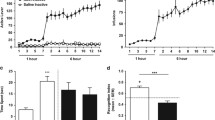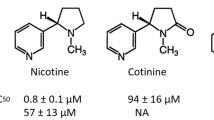Abstract
Rationale
Trace amine-associated receptor 1 (TAAR1) is a G protein-coupled receptor that has a particular role in regulating dopaminergic, serotonergic, and glutamatergic transmission. TAAR1 agonists have shown pro-cognitive activities. However, it remains largely unknown of the effects of TAAR1 agonists on memory performance.
Objectives
Here, by using the mice novel object recognition (NOR) test, we examined the effects of the selective TAAR1 partial agonist RO5263397 on recognition memory.
Results
We found that RO5263397 significantly enhanced the retrieval of short-term memory (STM; 20 min after training) both in male and female mice. RO5263397 promoted the retrieval of STM in the wild-type (WT) littermates but not TAAR1-KO mice, indicating that the effects of RO5263397 were dependent on TAAR1. Interestingly, compared to their WT litters, TAAR1-KO mice showed similar levels of STM, suggesting that genetic deletion of taar1 gene did not affect the STM retrieval. Furthermore, RO5263397 also promoted the retrieval of long-term NOR memory (24 h after training).
Conclusions
These results indicate that TAAR1 activation promotes NOR memory retrieval. Consistent with previous studies, our finding further suggests that TAAR1 agonists have pro-cognitive properties.



Similar content being viewed by others
References
Aben B, Stapert S, Blokland A (2012) About the distinction between working memory and short-term memory. Front Psychol 3:301
Accorroni A, Rutigliano G, Sabatini M, Frascarelli S, Borso M, Novelli E, Bandini L, Ghelardoni S, Saba A, Zucchi R, Origlia N (2020) Exogenous 3-iodothyronamine rescues the entorhinal cortex from beta-amyloid toxicity. Thyroid 30:147–160
Achat-Mendes C, Lynch LJ, Sullivan KA, Vallender EJ, Miller GM (2012) Augmentation of methamphetamine-induced behaviors in transgenic mice lacking the trace amine-associated receptor 1. Pharmacol Biochem Behav 101:201–207
Antunes M, Biala G (2012) The novel object recognition memory: neurobiology, test procedure, and its modifications. Cogn Process 13:93–110
Berry MD (2007) The potential of trace amines and their receptors for treating neurological and psychiatric diseases. Rev Recent Clin Trials 2:3–19
Berry MD, Gainetdinov RR, Hoener MC, Shahid M (2017) Pharmacology of human trace amine-associated receptors: therapeutic opportunities and challenges. Pharmacol Ther 180:161–180
Burchett SA, Hicks TP (2006) The mysterious trace amines: protean neuromodulators of synaptic transmission in mammalian brain. Prog Neurobiol 79:223–246
Cisneros IE, Ghorpade A (2014) Methamphetamine and HIV-1-induced neurotoxicity: role of trace amine associated receptor 1 cAMP signaling in astrocytes. Neuropharmacology 85:499–507
Cowan N (2008) What are the differences between long-term, short-term, and working memory? Prog Brain Res 169:323–338
Damiana Leo SE, Agnes Villers, Raul Gainetdinov, Laurence Ris (2019) Trace amine associate receptor 1 (TAAR1) as a new target for the treatment of cognitive dysfunction in Alzheimer disease. Front Neurosci Conference Abstract: 13th National Congress of the Belgian Society for Neuroscience
Davis RL, Zhong Y (2017) The Biology of Forgetting-A Perspective. Neuron 95:490–503
Di Cara B, Maggio R, Aloisi G, Rivet JM, Lundius EG, Yoshitake T, Svenningsson P, Brocco M, Gobert A, De Groote L, Cistarelli L, Veiga S, De Montrion C, Rodriguez M, Galizzi JP, Lockhart BP, Coge F, Boutin JA, Vayer P, Verdouw PM, Groenink L, Millan MJ (2011) Genetic deletion of trace amine 1 receptors reveals their role in auto-inhibiting the actions of ecstasy (MDMA). J Neurosci 31:16928–16940
Ebbinghaus H (2013) Memory: a contribution to experimental psychology. Ann Neurosci 20:155–156
Ennaceur A (2010) One-trial object recognition in rats and mice: methodological and theoretical issues. Behav Brain Res 215:244–254
Ennaceur A, Delacour J (1988) A new one-trial test for neurobiological studies of memory in rats. 1: Behavioral data. Behav Brain Res 31:47–59
Ennaceur A, Meliani K (1992) A new one-trial test for neurobiological studies of memory in rats. III. Spatial vs. non-spatial working memory. Behav Brain Res 51:83–92
Espinoza S, Lignani G, Caffino L, Maggi S, Sukhanov I, Leo D, Mus L, Emanuele M, Ronzitti G, Harmeier A, Medrihan L, Sotnikova TD, Chieregatti E, Hoener MC, Benfenati F, Tucci V, Fumagalli F, Gainetdinov RR (2015) TAAR1 modulates cortical glutamate NMDA receptor function. Neuropsychopharmacology 40:2217–2227
Gainetdinov RR, Hoener MC, Berry MD (2018) Trace amines and their receptors. Pharmacol Rev 70:549–620
Gale SD, Baxter L, Thompson J (2016) Greater memory impairment in dementing females than males relative to sex-matched healthy controls. J Clin Exp Neuropsychol 38:527–533
Goodman J, Packard MG (2016) Memory Systems and the Addicted Brain. Front Psychiatry 7:24
Goonawardena AV, Morairty SR, Dell R, Orellana GA, Hoener MC, Wallace TL, Kilduff TS (2019) Trace amine-associated receptor 1 agonism promotes wakefulness without impairment of cognition in Cynomolgus macaques. Neuropsychopharmacology 44:1485–1493
Goulart BK, de Lima MN, de Farias CB, Reolon GK, Almeida VR, Quevedo J, Kapczinski F, Schroder N, Roesler R (2010) Ketamine impairs recognition memory consolidation and prevents learning-induced increase in hippocampal brain-derived neurotrophic factor levels. Neuroscience 167:969–973
Hammond RS, Tull LE, Stackman RW (2004) On the delay-dependent involvement of the hippocampus in object recognition memory. Neurobiol Learn Mem 82:26–34
Herlitz A, Nilsson LG, Backman L (1997) Gender differences in episodic memory. Mem Cognit 25:801–811
Jonides J, Lewis RL, Nee DE, Lustig CA, Berman MG, Moore KS (2008) The mind and brain of short-term memory. Annu Rev Psychol 59:193–224
Kolb B, Whishaw IQ (1996) Fundamentals of human neuropsychology, 4th edn. W.H. Freeman, New York
Leger M, Quiedeville A, Bouet V, Haelewyn B, Boulouard M, Schumann-Bard P, Freret T (2013) Object recognition test in mice. Nat Protoc 8:2531–2537
Lindemann L, Meyer CA, Jeanneau K, Bradaia A, Ozmen L, Bluethmann H, Bettler B, Wettstein JG, Borroni E, Moreau JL, Hoener MC (2008) Trace amine-associated receptor 1 modulates dopaminergic activity. J Pharmacol Exp Ther 324:948–956
Liu J, Seaman R Jr, Johnson B, Wu R, Vu J, Tian J, Zhang Y, Li JX (2021) Activation of trace amine-associated receptor 1 selectively attenuates the reinforcing effects of morphine. Br J Pharmacol 178:933–945
Liu JF, Li JX (2018) TAAR1 in Addiction: Looking Beyond the Tip of the Iceberg. Front Pharmacol 9:279
Liu JF, Seaman R Jr, Siemian JN, Bhimani R, Johnson B, Zhang Y, Zhu Q, Hoener MC, Park J, Dietz DM, Li JX (2018) Role of trace amine-associated receptor 1 in nicotine’s behavioral and neurochemical effects. Neuropsychopharmacology 43:2435–2444
Liu JF, Thorn DA, Zhang Y, Li JX (2016) Effects of trace amine-associated receptor 1 agonists on the expression, reconsolidation, and extinction of cocaine reward memory. Int J Neuropsychopharmacol 19
Manni ME, De Siena G, Saba A, Marchini M, Landucci E, Gerace E, Zazzeri M, Musilli C, Pellegrini-Giampietro D, Matucci R, Zucchi R, Raimondi L (2013) Pharmacological effects of 3-iodothyronamine (T1AM) in mice include facilitation of memory acquisition and retention and reduction of pain threshold. Br J Pharmacol 168:354–362
Pauls F, Petermann F, Lepach AC (2013) Gender differences in episodic memory and visual working memory including the effects of age. Memory 21:857–874
Pei Y, Asif-Malik A, Canales JJ (2016) Trace amines and the trace amine-associated receptor 1: Pharmacology, Neurochemistry, and Clinical Implications. Front Neurosci 10:148
Revel FG, Moreau JL, Gainetdinov RR, Bradaia A, Sotnikova TD, Mory R, Durkin S, Zbinden KG, Norcross R, Meyer CA, Metzler V, Chaboz S, Ozmen L, Trube G, Pouzet B, Bettler B, Caron MG, Wettstein JG, Hoener MC (2011) TAAR1 activation modulates monoaminergic neurotransmission, preventing hyperdopaminergic and hypoglutamatergic activity. Proc Natl Acad Sci U S A 108:8485–8490
Revel FG, Moreau JL, Gainetdinov RR, Ferragud A, Velazquez-Sanchez C, Sotnikova TD, Morairty SR, Harmeier A, Groebke Zbinden K, Norcross RD, Bradaia A, Kilduff TS, Biemans B, Pouzet B, Caron MG, Canales JJ, Wallace TL, Wettstein JG, Hoener MC (2012) Trace amine-associated receptor 1 partial agonism reveals novel paradigm for neuropsychiatric therapeutics. Biol Psychiatry 72:934–942
Revel FG, Moreau JL, Pouzet B, Mory R, Bradaia A, Buchy D, Metzler V, Chaboz S, Groebke Zbinden K, Galley G, Norcross RD, Tuerck D, Bruns A, Morairty SR, Kilduff TS, Wallace TL, Risterucci C, Wettstein JG, Hoener MC (2013) A new perspective for schizophrenia: TAAR1 agonists reveal antipsychotic- and antidepressant-like activity, improve cognition and control body weight. Mol Psychiatry 18:543–556
Rutigliano G, Accorroni A, Zucchi R (2017) The Case for TAAR1 as a Modulator of Central Nervous System Function. Front Pharmacol 8:987
Sara SJ (2000) Strengthening the shaky trace through retrieval. Nat Rev Neurosci 1:212–213
Silvers JM, Harrod SB, Mactutus CF, Booze RM (2007) Automation of the novel object recognition task for use in adolescent rats. J Neurosci Methods 166:99–103
Taglialatela G, Hogan D, Zhang WR, Dineley KT (2009) Intermediate- and long-term recognition memory deficits in Tg2576 mice are reversed with acute calcineurin inhibition. Behav Brain Res 200:95–99
Thorn DA, Jing L, Qiu Y, Gancarz-Kausch AM, Galuska CM, Dietz DM, Zhang Y, Li JX (2014) Effects of the trace amine-associated receptor 1 agonist RO5263397 on abuse-related effects of cocaine in rats. Neuropsychopharmacology 39:2309–2316
White NM (1996) Addictive drugs as reinforcers: multiple partial actions on memory systems. Addiction 91: 921–49; discussion 951–65
Wolinsky TD, Swanson CJ, Smith KE, Zhong H, Borowsky B, Seeman P, Branchek T, Gerald CP (2007) The Trace Amine 1 receptor knockout mouse: an animal model with relevance to schizophrenia. Genes Brain Behav 6:628–639
Wu R, Liu J, Wang K, Huang Y, Zhang Y, Li JX (2020) Effects of a trace amine-associated receptor 1 agonist RO 5263397 on ethanol-induced behavioral sensitization. Behav Brain Res 390:112641
Zhang Y, Li JT, Wang H, Niu WP, Zhang CC, Zhang Y, Wang XD, Si TM, Su YA (2021) Role of trace amineassociated receptor 1 in the medial prefrontal cortex in chronic social stress-induced cognitive deficits in mice. Pharmacol Res 167:105571
Acknowledgements
We thank Dr. Gregory M Miller at Northeastern University (Boston, MA, USA) for providing with us the breeding pairs of TAAR1 knockout mice.
Funding
This work was supported by the National Institutes of Health National Institute on Drug Abuse (grant number R01DA047967 to J-X.L.).
Author information
Authors and Affiliations
Contributions
R.W., J. L., and J-X.L. designed the study; R.W., J. L., R.S., and B.J. conducted experiments; Y.Z. provided the TAAR1 agonist RO5263397; R.W., J.L., and J-X.L. prepared the manuscript. All authors read and approved the final version of the manuscript.
Corresponding author
Ethics declarations
Conflict of interest
The authors declare no conflict of interest.
Disclaimer
The content is solely the responsibility of the authors and does not necessarily represent the official views of the National Institutes of Health.
Additional information
Publisher's Note
Springer Nature remains neutral with regard to jurisdictional claims in published maps and institutional affiliations.
Rights and permissions
About this article
Cite this article
Wu, R., Liu, J., Seaman, R. et al. The selective TAAR1 partial agonist RO5263397 promoted novelty recognition memory in mice. Psychopharmacology 238, 3221–3228 (2021). https://doi.org/10.1007/s00213-021-05937-1
Received:
Accepted:
Published:
Issue Date:
DOI: https://doi.org/10.1007/s00213-021-05937-1




